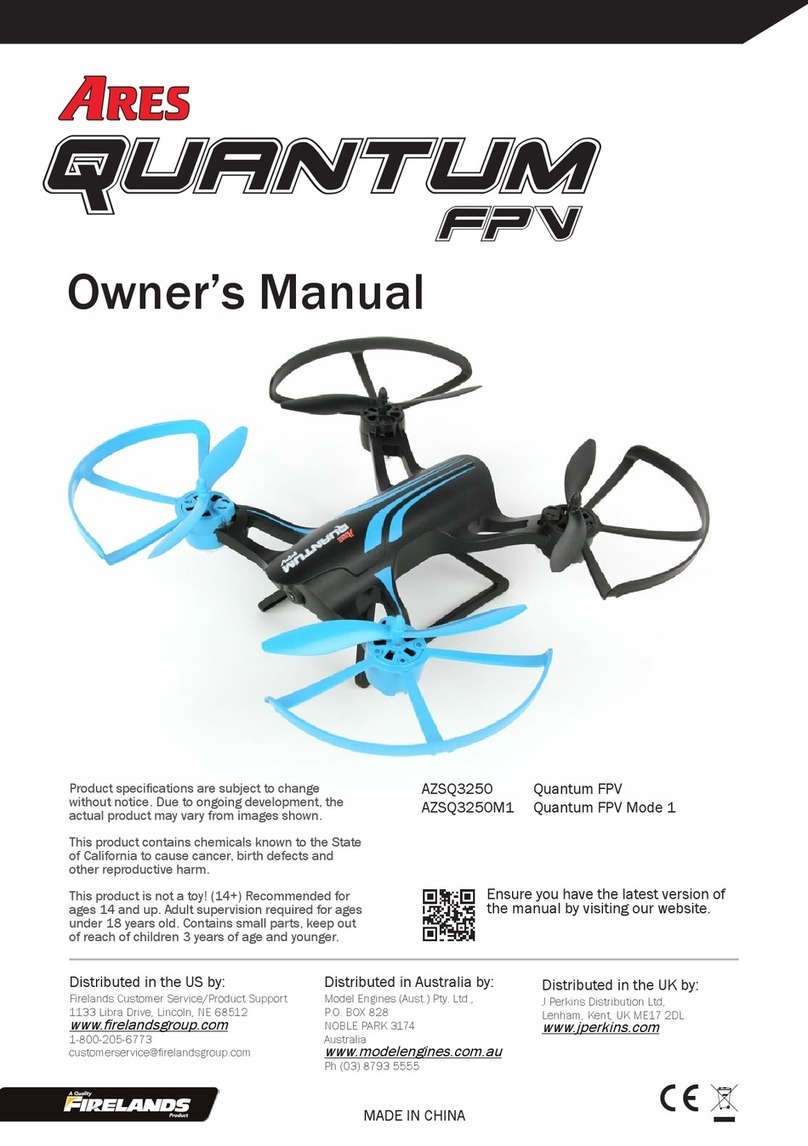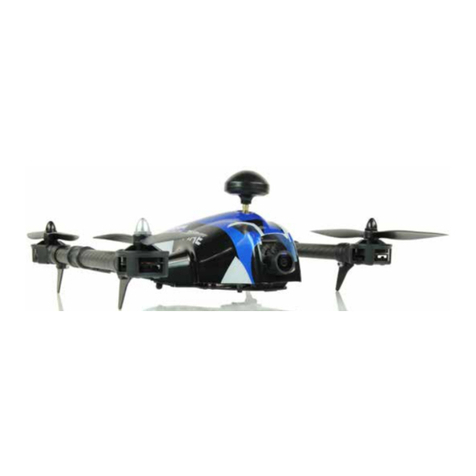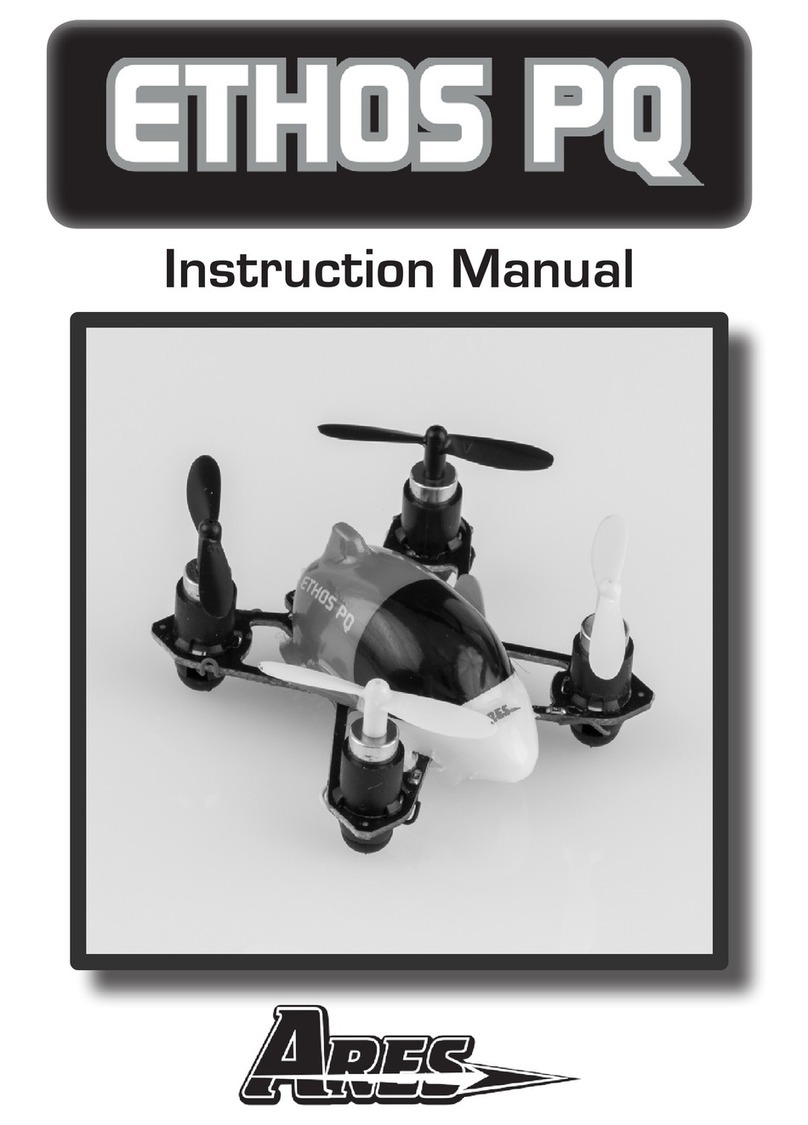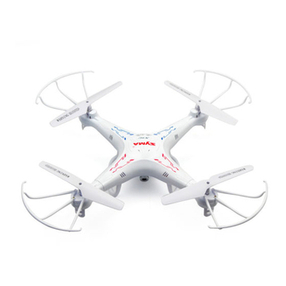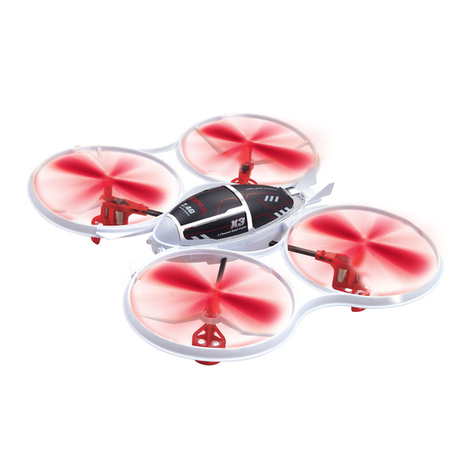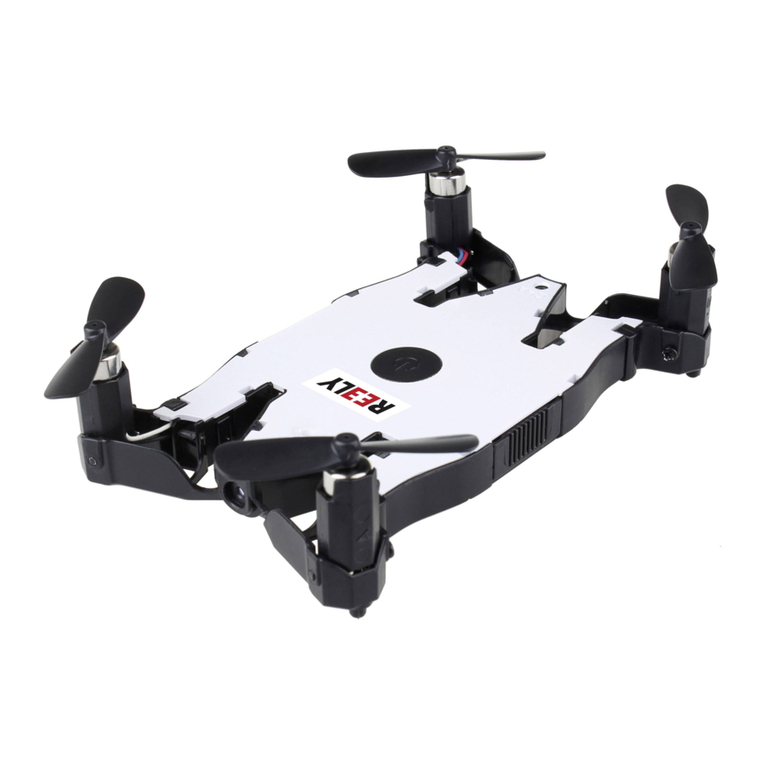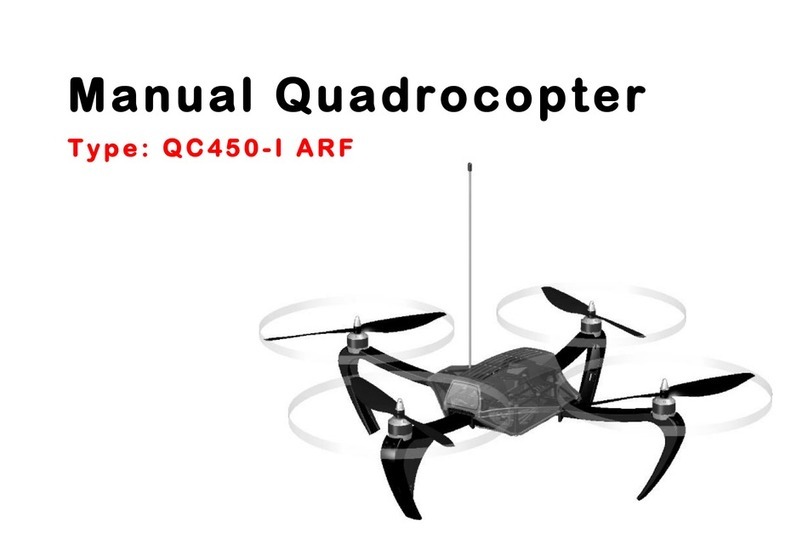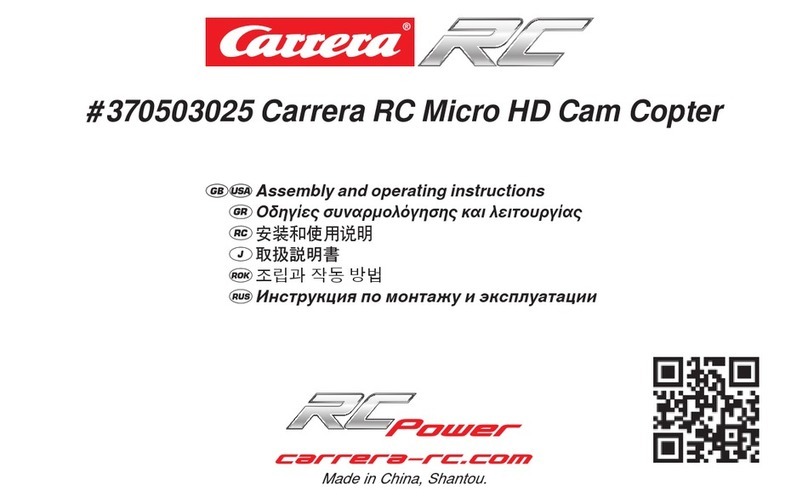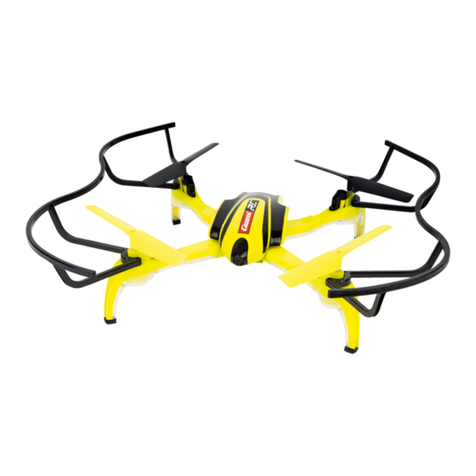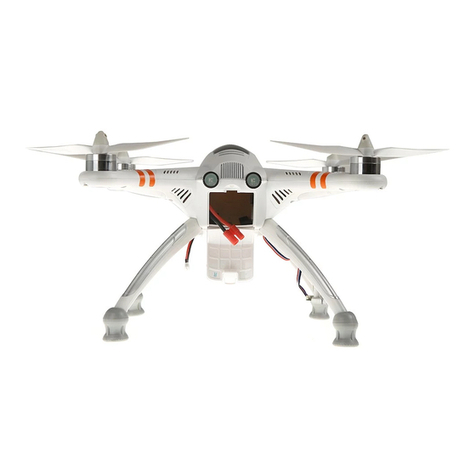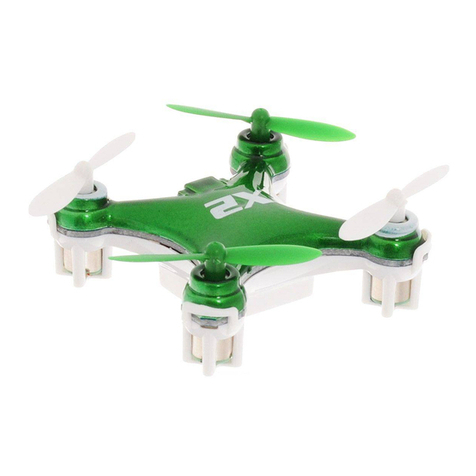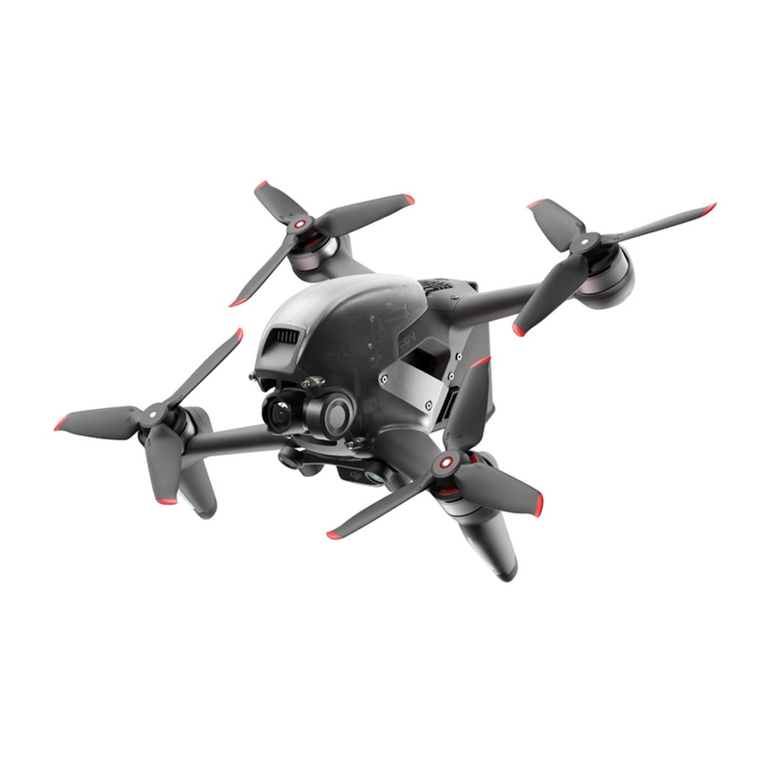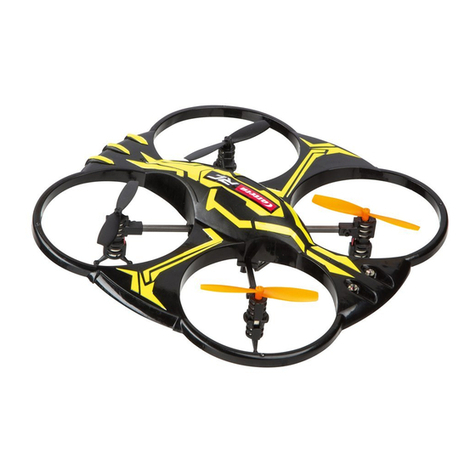Ares Ethos QX 75 User manual

1
Length: 3.7 in (95mm)
Length Including Rotor Blades: 5.5 in (140mm)
Height: 1.7 in (44mm)
Propeller/Main Rotor Diameter: 2.2 in (56mm)
Weight with Battery: 1.3 oz (37 g)
Main Motor: Micro coreless (4 installed)
Battery: 300mAh 1S 3.7V LiPo (included)
Charger: Dual Port 1S 3.7V LiPo DC USB (included)
Transmitter: 4-channel 2.4GHz (included)
On-Board Electronics: 4-in-1 receiver/4 ESCs/mixer/3-axis gyro (installed)
Specifications
Instruction Manual

2
Specifications.......................................................................................................................................... 1
Introduction ............................................................................................................................................. 2
Safety Precautions and Warnings....................................................................................................... 3
CE Information........................................................................................................................................ 4
Ethos QX 75 RTF (Ready-To-Fly) Contents...................................................................................... 5
Before the First Flight Checklist........................................................................................................... 6
Flight Checklist ....................................................................................................................................... 6
LiPo Battery Warnings and Usage Guidelines .................................................................................. 7
Charging the LiPo Flight Battery.......................................................................................................... 9
Installing the Transmitter Batteries.................................................................................................... 11
Transmitter Details............................................................................................................................... 11
Installing the LiPo Flight Battery........................................................................................................ 13
Control Unit Initialization and Arming................................................................................................ 15
Transmitter Dual Rates ....................................................................................................................... 17
Flight Controls and Trimming............................................................................................................. 19
Selecting a Flying Area ....................................................................................................................... 23
Flying...................................................................................................................................................... 23
Automatic Flip Mode............................................................................................................................ 25
Transmitter and Receiver Binding/Linking ....................................................................................... 28
Replacement Parts List....................................................................................................................... 29
Warranty, Support and Service.......................................................................................................... 29
Exploded View Parts Listing............................................................................................................... 30
Exploded View...................................................................................................................................... 31
Table of Contents

3
The Ares™ [air-eez]Ethos QX 75 may be small in size but it’s big on performance and
capability for both first-time and experienced quadcopter pilots. The advanced 3-axis gyro
control system offers precise control and maximum stability while the nano-micro size allows
for easy flying in smaller indoor spaces and fully proportional 4-channel control offers plenty
of maneuverability for flying outdoors in light wind conditions too.
The innovative ‘Automatic Flip Mode’ allows almost anyone to perform 360° flips with just
the push of a button on the transmitter and the unique body design offers improved visibility
to help maintain orientation. An advanced design and composite materials result in low
weight and incredible durability plus the airframe is 100% factory-assembled and ready-to-fly
right out of the box – no tools or assembly required!
Also in the box is everything needed to fly including AA batteries for the ergonomic 4-channel
transmitter equipped with 2.4GHz technology, an LCD screen, dual rates and a built-in USB
port, a class-leading 300mAh 1S 3.7V LiPo battery and a dual port DC USB charger for charging
from almost any computer or USB power source. That means there’s nothing extra to buy and
you can be ready to fly within minutes of opening the box.
And although the Ethos QX 75 is ready-to-fly right out the box, please take the time to read
through this manual for more information on battery safety and charging, flight controls and
more before making your first flight. Please also visit our web site at www.Ares-RC.com for
additional information including product updates, bulletins, videos and more.
Failure to use this product in the intended manner as described in the following instructions
can result in damage and/or personal injury. A Radio Controlled (RC)
airplane/helicopter/quadcopter is not a toy! If misused it can cause serious bodily harm and
damage to property.
Keep items that could become entangled in the propeller/rotor blades away from the
propeller/rotor blades, including loose clothing, tools, etc. Be especially sure to keep your
hands, face and other parts of your body away from the propeller/rotor blades.
Introduction
Safety Precautions and Warnings

4
As the user of this product you are solely and wholly responsible for operating it in a manner
that does not endanger yourself and others or result in damage to the product or the
property of others.
This model is controlled by a radio signal that is subject to possible interference from a variety
of sources outside your control. This interference can cause momentary loss of control so it is
advisable to always keep a safe distance from objects and people in all directions around your
model as this will help to avoid collisions and/or injury.
•Never operate your model if the voltage of the batteries in the transmitter is too low.
•Always operate your model in an open area away from obstacles, people, vehicles,
buildings, etc.
•Carefully follow the directions and warnings for this and any optional support
equipment (chargers, rechargeable batteries, etc.).
•Keep all chemicals, small parts and all electronic components out of the reach of
children.
•Moisture causes damage to electronic components. Avoid water exposure to all
electronic components, parts, etc. not specifically designed and protected for use in
water.
•Never lick or place any portion of the model in your mouth as it could cause serious
injury or even death.
Intended Use
The remote control is designed exclusively for private use in model construction. The remote
control is not for industrial use, e.g. to control machines and equipment, determined.
Any use other than as described above, can lead to damage of the product, and beyond this,
with the associated risks, such as short circuit, fire, electric shock, etc..
Contact with water must be avoided!
The remote control must not technically be changed or rebuilt!
The safety precautions are essential to follow!
You as a user are solely responsible for the safe operation of your remote control and your
model!
Declaration of Conformity (DOC)
Hereby, the manufacturer declares that this product is in compliance with the essential
requirements and other relevant provisions of Directives.
The declaration of conformity may be consulted at www.robitronic.com
CE Information

5
Item Description
Not Available Separately....Ethos QX 75 Nano-Micro RTF Airframe
AZSH1208 ...........................M4LPQ Micro 4-Channel LP Quadcopter Transmitter, Mode 2
Not Available Separately....6 AA Batteries
AZSH1203 ...........................DC USB Power Cable/Cord for Dual Port Charger
AZSH1204 ...........................1-Cell/1S 3.7V LiPo, 0.4A Dual Port DC USB Charger
AZSH1205 ...........................300mAh 1-Cell/1S 3.7V 15C LiPo Battery, Micro A Connector
Ethos QX 75 RTF (Ready-To-Fly) Contents

6
PLEASE NOTE: This checklist is NOT intended to replace the content included in this
instruction manual. Although it can be used as a quick start guide, we strongly suggest
reading through this manual completely before proceeding.
Remove and inspect all contents
Plug the DC USB charger into a suitable USB power source
Begin charging the flight battery (connect it to the charger)
Install the six AA batteries in the transmitter
Install the flight battery in the quadcopter (after it’s been fully charged)
Familiarize yourself with the controls
Test the controls to confirm proper operation
Find a suitable area for flying
PLEASE NOTE: This checklist is NOT intended to replace the content included in this
instruction manual. Although it can be used as a quick start guide, we strongly suggest
reading through this manual completely before proceeding.
Always turn the transmitter on first
Plug the flight battery into the model
Allow the control unit to initialize and arm properly (on a flat/level surface)
Fly the model (take-off from a flat/level surface)
Land the model (land on a flat/level surface)
Unplug the flight battery from the model
Always turn the transmitter off last
Before the First Flight Checklist
Flight Checklist

7
IMPORTANT NOTE: Lithium Polymer batteries are significantly more volatile than the
alkaline, NiCd or NiMH batteries also used in RC applications. All instructions and warnings
must be followed exactly to prevent property damage and/or personal injury as
mishandling of LiPo batteries can result in fire.
By handling, charging or using the included LiPo battery you assume all risks associated
with LiPo batteries. If you do not agree with these conditions please return the complete
product in new, unused condition to the place of purchase immediately.
And although the 300mAh 1-Cell/1S 3.7V 15C LiPo Battery (AZSH1205)included with your
Ares™ Ethos QX 75 is intended to be charged safely using the included 1-Cell/1S 3.7V LiPo,
0.4A Dual Port DC USB Charger (AZSH1204) you must read the following safety instructions
and warnings before handling, charging or using the LiPo battery.
•You must charge the LiPo battery in a safe area away from flammable materials.
•Never charge the LiPo battery unattended at any time. When charging the battery
you should always remain in constant observation to monitor the charging process
and react immediately to any potential problems that may occur.
•After flying/discharging the battery you must allow it to cool to ambient/room
temperature before recharging.
•To charge the battery you must use only the included 1-Cell/1S 3.7V LiPo, 0.4A DC
Dual Port USB Charger (AZSH1204) or a suitably compatible LiPo battery charger.
Failure to do so may result in a fire causing property damage and/or personal injury.
DO NOT use a NiCd or NiMH charger.
•If at any time during the charge or discharge process the battery begins to balloon or
swell, discontinue charging or discharging immediately. Quickly and safely
disconnect the battery, then place it in a safe, open area away from flammable
materials to observe it for at least 15 minutes. Continuing to charge or discharge a
battery that has begun to balloon or swell can result in a fire. A battery that has
ballooned or swollen even a small amount must be removed from service
completely.
•Store the battery at room temperature, approximately 68–77° Fahrenheit (F), and in
a dry area for best results.
LiPo Battery Warnings and Usage Guidelines

8
•When transporting or temporarily storing the battery, the temperature range should
be from approximately 40–100°F. Do not store the battery or model in a hot garage,
car or direct sunlight whenever possible. If stored in a hot garage or car the battery
can be damaged or even catch fire.
•Do not over-discharge the LiPo flight battery. Discharging the LiPo flight battery too
low can cause damage to the battery resulting in reduced power, flight duration or
failure of the battery entirely.
LiPo cells should not be discharged to below 3.0V each under load. In the case of the
1-Cell/1S 3.7V LiPo battery used to power the Ethos QX 75 you will not want to allow
the battery to fall below 3.0V during flight.
The 4-in-1 control unit features a low voltage cutoff (LVC) that cuts power to the
motors completely (regardless of the power level you have set with the left-
hand/throttle stick) if the voltage of the battery falls below the 3.0V minimum. If the
LVC ever occurs it will be indicated by a blinking red LED. However, to prevent an
unexpected loss of power due to triggering the LVC, if you ever find that more than
the typical amount of throttle/power is required to hover and/or the quadcopter will
not ascend/climb even at full power you should land the model and disconnect the
battery immediately to prevent over-discharge.
And while it is possible to power the model up and fly again after the LVC occurs this
is NOT recommended. Continued discharging can cause permanent damage to the
LiPo battery resulting in reduced power output and/or shortened flight durations
during subsequent flights (or failure of the battery entirely).
Also, it is not recommended that you fly to the LVC every time you fly. Instead you
should be aware of the power level of the battery/quadcopter throughout the flight,
and if at any time the quadcopter begins to require more throttle/power than typical
to maintain hover, and/or will not ascend/climb even at full power, you should land
the quadcopter and disconnect the LiPo battery immediately. Constantly discharging
the battery to the LVC can still cause permanent damage to the battery so it’s best to
use a timer or stop-watch to time the duration of your flights and to stop flying at a
reasonable time before the LVC is reached.

9
You must charge the included 300mAh 1-Cell/1S 3.7V 15C LiPo Battery (AZSH1205) using
only the included 1-Cell/1S 3.7V LiPo, 0.4A Dual Port DC USB Charger (AZSH1204) or a
suitably compatible LiPo battery charger. Charging the LiPo battery using a non-LiPo battery
compatible charger (such as a NiCd or NiMH battery charger), or even a different LiPo
battery charger with the incorrect settings, may result in damage to the battery or even fire
resulting in property damage and/or personal injury.
Please follow these steps to charge the LiPo battery with the included charger:
Using the included power cable/cord connect the Dual Port DC USB charger to a
suitable 5V USB port on a computer, other device or the USB port on the bottom of
the transmitter. Another option is to plug the optional 5005PS 100-240V AC to 5V DC
USB, 0.5-Amp Power Supply (AZSC5005PS) into a compatible 100-240V AC outlet
then to connect the charger to the power supply/AC adapter accordingly. The power
supply/AC adapter is powered on when the LED indicator glows solid green.
NOTE: The AA batteries included to power the transmitter are not intended to be
used to power the included charger (to charge the LiPo flight battery) through the
built-in USB port on the transmitter. If you’d like to power the included charger
through the USB port on the transmitter we recommend replacing the AA
batteries with Energizer® MAX brand or equivalent capacity (~2800mAh per cell)
alkaline/rechargeable AA batteries. These AA batteries can deliver enough power
to charge a fully discharged (not over-discharged) LiPo flight battery up to 5-7
times before they need to be replaced. Also, as the voltage of the AA batteries
drops it will take more time to charge the LiPo flight battery.
Connect the white 2-pin ‘Micro A’ connector on the battery to one of the mating
connectors on the charger. YOU MUST BE CAREFUL TO ENSURE PROPER POLARITY
BEFORE MAKING THE CONNECTION by ensuring the red color positive (+) wire lead is
aligned with the positive (+) marking on the housing of the charger. While the Micro
A connectors are ‘keyed’ to minimize the risk of a reverse polarity connection, if you
force them it is possible to make connection with the incorrect polarity potentially
causing damage to the battery and/or charger. When the red wire lead is properly
aligned with the positive (+) marking on the housing of the charger, connecting the
Micro A connector should require only a minimal amount of pressure to achieve the
light ‘click’ that indicates secure connection.
Charging the LiPo Flight Battery

10
When the battery is connected to the charger securely and with the proper polarity
the LED indicator on the charger will glow solid red. The battery will be charging
anytime it’s connected to the charger and the LED indicator is glowing solid red
It will take approximately 50-60 minutes to charge a fully discharged (not over-
discharged) battery from a suitable power source. And when the battery is fully
charged the LED indicator will stop glowing red entirely. When the LED indicator is no
longer glowing you can disconnect the battery from the charger as it is now fully
charged and ready for use.
NOTE: When using both charge ports at the same time to charge two (2) fully
discharged (not over-discharged) batteries, the charge time may increase by
approximately 30 minutes per battery (or more) depending on the amount of power
available from your source. Also, we do NOT recommend charging two (2) batteries
when the charger is connected to the transmitter as a power source as even the highest
capacity AA batteries will not deliver adequate power/life.
NOTE:The LiPo battery included with your model will arrive partially charged. For this
reason the initial charge may only take approximately 25-30 minutes.
NOTE: It’s safer and better for the longevity of the battery to store it only partially
charged for any length of time. Storing the battery at approximately 50% charged (which
is approximately 3.85V per cell) is typically best; however, it will take some careful
management of the charge time and the use of a volt meter to achieve this voltage.
If you have the equipment and skills to achieve the 50% charge level for storage it is
recommended. If not, simply be sure to not store the battery fully charged whenever
possible. In fact, as long as the battery will be stored at approximately room temperature
and for no more than a few weeks before the next use, it may be best to store the battery
in the discharged state after the last flight (as long as the battery was not over-discharged
on the last flight).

11
Install the six included AA batteries in the back of the transmitter by removing the screw
securing the battery compartment cover/door using the included screwdriver then remove
the battery compartment cover/door. Ensure proper polarity of the batteries before installing
them as indicated by the markings molded into the battery compartment, then re-install the
compartment cover/door and screw.
Check for proper operation of the transmitter by sliding the power switch to the ON position
(slide it to the right). The red LED indicator at the top of the transmitter will begin to blink and
the LCD screen will power on. This indicates the transmitter is powered on and the AA
batteries are installed correctly.
NOTE: The LED indicator will not glow solid red, and the LCD screen will not display the
current control stick/trim positions and other typical data/information, until after the
quadcopter has been powered ON and the binding/linking process is complete (please see
‘Control Unit Initialization and Arming’ and the ‘Transmitter and Receiver Binding/Linking’
sections of this manual for more information).
The Ethos QX 75 includes an M4LPQ Micro 4-Channel LP Quadcopter Transmitter
equipped with 2.4GHz technology, dual rates, digital trims and an LCD screen.
Installing the Transmitter Batteries
Transmitter Details

12
The unique LCD screen displays a variety of data when the transmitter is powered on:
Dual Rate Status Indicator
This indicator shows the control rate mode currently selected; ‘FULL’ for high rate and
‘HALF’ for low rate (please see the ‘Transmitter Dual Rates’ section of this manual for
more information).
Battery Power Indicator
This indicator shows the approximate amount of AA battery power remaining for the
transmitter. We suggest replacing the AA batteries in the transmitter anytime there are
only one or two rectangles showing (around 7.2– 7.5V).
Throttle, Rudder, Elevator and Aileron Channel Output/Stick Position Value
This value indicates the approximate percentage (%) of channel output/stick position or
trim position for a given channel/function. The value shown is from the most recent
control stick movement or trim button press; for example, after moving the left-
hand/throttle stick down to the lowest possible position the value shown will be ‘00%’.

13
Rudder Channel Trim Position Indicator
This indicator shows the approximate rudder channel trim position. The trim position
should be adjusted as needed during flight to ensure the nose of the quadcopter does
not constantly turn (yaw) left or right when ‘hovering’ and without any rudder/left-hand
stick input.The percentage value for the trim position is also shown on the right side of
the LCD screen after pressing either of the trim buttons (and only prior to the next
control stick movement or trim button press).
Elevator and Aileron Channel Trim Position Indicators
These indicators show the approximate elevator and aileron channel trim positions. The
trim positions should be adjusted as needed during flight to ensure the quadcopter does
not constantly ‘drift’ forward/backward (elevator) or left/right (aileron) when hovering
and without any right-hand stick input. The percentage value for the corresponding trim
position is also shown on the right side of the LCD screen after pressing either of the
trim buttons (and only prior to the next control stick movement or trim button press).In
general these trim positions will not often change after they’ve been set correctly.
NOTE: The unique position of the elevator trim buttons is due to the ergonomic design
of the transmitter. The functions of these buttons are clearly noted on the
corresponding label and it will not typically be necessary to adjust the elevator trim
position after it’s been set correctly.
IMPORTANT NOTE: You must ALWAYS turn the transmitter on first, BEFORE
installing/connecting the LiPo flight battery. And before proceeding with the following
steps please be sure the transmitter is powered on and that the left-hand/throttle stick is in
the lowest possible position.
IMPORTANT NOTE: It’s important that you do not move the left-hand/throttle stick up and
down after the transmitter is powered on and before the 4-in-1 control unit installed in the
quadcopter is powered on as doing so will prevent the transmitter from binding/linking to
the receiver/control unit.
NOTE: While the ‘Micro A’ connectors installed on the wire leads of the battery and the 4-in-1
control unit are ‘keyed’ to minimize the risk of a reverse polarity connection, if you force
them it is possible to make connection with incorrect polarity potentially causing damage to
the control unit and/or battery. When the connectors are properly aligned for correct
polarity, connecting the Micro A connectors should require only a minimal amount of
pressure to achieve the light ‘click’ that indicates secure connection.
Installing the LiPo Flight Battery

14
After the LiPo battery has been fully charged it’s ready to be installed in the quadcopter.
Install the flight battery by sliding it into the battery mount (located on the bottom of the
main frame) with the wire leads and connector oriented towards the back of the quadcopter.
IMPORTANT NOTE: You should always position the battery so it’s approximately ‘centered’
relative to the front and back of the battery mount. This helps to ensure proper Center-of-
Gravity (CG) for the quadcopter and will minimize or eliminate the need to adjust the
elevator channel trim position after installing a different battery.
YOU MUST BE CAREFUL TO ENSURE PROPER POLARITY BEFORE CONNECTING THE BATTERY
TO THE 4-IN-1 CONTROL UNIT. By orienting/aligning the wire leads of the battery and
control unit so they’re ‘red to red’ and ‘black to black’ you’ll be able to make the connection
with correct polarity.
IMPORTANT NOTE: ONCE THE BATTERY IS CONNECTED TO THE CONTROL UNIT IT’S
IMPORTANT TO QUICKLY SET THE QUADCOPTER DOWN ON A STABLE, FLAT AND LEVEL
SURFACE IN ORDER FOR THE 3-AXIS GYRO SYSTEM TO INITIALIZE/CALIBRATE PROPERLY.
FAILURE TO QUICKLY SET THE QUADCOPTER DOWN CAN PREVENT THE GYRO SYSTEM
FROM INITIALIZING/CALIBRATING PROPERLY RESULTING IN UNSTABLE (OSCILLATING)
FLIGHT PERFORMANCE. Alternatively you can connect the battery to the control unit while
the quadcopter is set on a stable, flat and level surface.

15
When the battery is connected securely carefully ‘tuck’ the wire leads and connectors into
the body/canopy of the quadcopter. YOU MUST ENSURE THE WIRE LEADS AND
CONNECTORS WILL NOT COME INTO CONTACT WITH THE PROPELLERS/ROTOR BLADES
WHEN THEY SPIN.
To remove the LiPo flight battery carefully disconnect it from the 4-in-1 control unit
then remove it from the battery mount. DO NOT turn off the transmitter until the LiPo
flight battery is removed from the quadcopter and the 4-in-1 control unit is powered off.
REMEMBER: The transmitter is always on first and always off last!
The Ethos QX 75 is equipped with a compact and advanced 4-in-1 control unit. The control
unit is a lightweight combination of 2.4GHz receiver, four electronic speed controls (ESCs),
mixer and 3-axis gyro. The control unit is also equipped with LEDs that provide various
indications.
This checklist includes the steps you must follow to ensure proper initialization, arming and
operation of the control unit:
Before each flight you must always turn the transmitter on before connecting
the flight battery to the control unit. Never connect the flight battery to the
control unit before powering the transmitter on first. After each flight you
should always disconnect the flight battery from the control unit before turning
the transmitter off.
The left-hand/throttle stick must be set in the lowest possible position in order
for the control unit to arm properly. Failure to lower the stick to the lowest
possible position can prevent the ESCs from arming and/or the 3-axis gyro
system from initializing properly resulting in unstable (oscillating) flight
performance.
NOTE: It’s important that you do not move the left-hand/throttle stick up and
down after the transmitter is turned on and before the 4-in-1 control unit
installed in the quadcopter is powered on as doing so will prevent the
transmitter from binding/linking to the receiver/control unit.
Control Unit Initialization and Arming

16
Power the transmitter on and confirm that the LED indicator is blinking red. Then,
slide the flight battery into the battery mount (located on the bottom of the main
frame) and connect it to the control unit.
NOTE: If this will be the first flight, or the first flight following repairs, you
should ‘center’ the rudder, elevator and aileron channel trims. Use the digital
trim buttons to determine the center trim position by referencing the
percentage value indicated on the LCD screen (please see the ‘Transmitter
Details’ section of this manual for more information).
With the flight battery connected to the control unit the LED indicator on the
control unit will glow solid green.
IMPORTANT NOTE: ONCE THE BATTERY IS CONNECTED TO THE CONTROL UNIT IT’S
IMPORTANT TO QUICKLY SET THE QUADCOPTER DOWN ON A STABLE, FLAT AND
LEVEL SURFACE IN ORDER FOR THE 3-AXIS GYRO SYSTEM TO INITIALIZE/CALIBRATE
PROPERLY. FAILURE TO QUICKLY SET THE QUADCOPTER DOWN CAN PREVENT THE
GYRO SYSTEM FROM INITIALIZING/CALIBRATING PROPERLY RESULTING IN UNSTABLE
(OSCILLATING) FLIGHT PERFORMANCE. Alternatively you can connect the battery to
the control unit while the quadcopter is set on a stable, flat and level surface.

17
If you do not set the quadcopter down quickly after the battery is connected
you must disconnect it from the control unit and repeat the
initialization/calibration process.
When the LED indicator glows solid green the control unit is initialized and
ready for flight. Use caution as all four propellers/rotor blades will now spin
with left-hand/throttle stick input!
In case the LED indicator does not glow solid green:
•If the red and green LED indicators blink rapidly you do not have a positive radio
frequency (RF) link between the transmitter and receiver of the control unit.
First, check to be sure the transmitter is powered on and the LED indicator on the
transmitter is blinking red. If the transmitter is powered on and functioning
properly, disconnect the flight battery from the control unit. Then reconnect the
flight battery and now the control unit should initialize properly. Or, in some
cases, it may be necessary to power the transmitter off then on again before
reconnecting the flight battery to ensure proper initialization.
• If the red LED indicator is blinking slowly you have a positive RF link between the
transmitter and receiver of the control unit but the ESCs/motors did not ‘arm’
because the left-hand/throttle stick may not be set to the correct position. Check
to be sure the left-hand/throttle stick is in the lowest possible position, and once
in the correct position the green LED indicator will glow solid indicating the
ESCs/motors are now armed.
After confirming the control unit is initialized and the ESCs/motors have armed properly
your Ethos QX 75 is ready to fly. However, please review the following sections of the
manual BEFORE proceeding with the first flight.
The M4LPQ transmitter is equipped with a ‘dual rate’ feature. This feature allows you to
toggle between the ‘High’ (HI/FULL) and ‘Low’ (LO/HALF) control rates available for the
aileron and elevator channels. You can toggle between the high and low rates by
pressing the dual rate button (the right side of the rocker switch) located on the top left
‘corner’ of the transmitter. You should feel a ‘click’ and also hear an audible beep/tone
that indicates which control rate mode you are in. Two (2) beeps/tones means you’ve
selected high/’FULL’ rate mode and one (1) beep/tone means you’ve selected
low/’HALF’ rate mode. Also, the selected rate mode will be displayed as ‘FULL’ for high
rate and ‘HALF’ for low rate on the LCD screen.
Transmitter Dual Rates

18
NOTE: The transmitter will remember the last rate mode you selected even if it’s turned
off then on again. This means each time the transmitter is powered on it will
automatically be in the rate mode that was selected before it was powered off.
In the FULL/high rate mode the controls are allowed to reach their maximum values.
This mode is typically preferred by experienced pilots interested most in maximum
control authority.
By pressing the dual rate button (the right side of the rocker switch) located on the top
left ‘corner’ of the transmitter while in the FULL/high rate mode you’ll switch to the
HALF/low rate mode. You’ll know you’ve switched to the ‘HALF’/low rate mode after
feeling a ‘click’ and hearing a single beep/tone.
The HALF/low rate mode is typically preferred by (and recommended best for)
first-time, low-time and other pilots interested most in a reduced amount of control
authority that allows for even smoother and more easily controlled hovering and flying.
If you ever switch to the HALF/low rate mode you’ll know you’ve switched back to the
FULL/high rate mode by pressing the dual rate button (the right side of the rocker
switch), feeling the click and also hearing two (2) beeps/tones.

19
In the event you are not familiar with the controls of the Ethos QX 75 please take the time
to familiarize yourself with them as follows and before attempting your first flight:
The left-hand stick on the transmitter controls both throttle (climb/descend) and rudder (yaw
left/right). When the left-hand stick (also known as the ‘throttle’ stick) is in the lowest
possible position the propellers/rotor blades will not spin. Moving the stick upward will
increase the speed of the propellers/rotor blades. Increasing the speed of the
propellers/rotor blades will cause the model to climb.
Decreasing the speed of the propellers/rotor blades by lowering the left-hand stick will cause
the model to descend.
After lifting the model off the ground you can ‘hover’ by carefully moving the left-hand stick
up and down slightly as needed so the model will maintain altitude without climbing or
descending.
Flight Controls and Trimming

20
Moving the left-hand stick to the left will turn (yaw) the nose of the quadcopter to the left
about the vertical axis. This is accomplished by increasing the speed of the left-front and
right-rear propellers/rotor blades while decreasing the speed of the right-front and left-rear
propellers/rotor blades.
Moving the stick to the right will turn (yaw) the nose of the quadcopter to the right about the
vertical axis. This is accomplished by increasing the speed of the right-front and left-rear
propellers/rotor blades while decreasing the speed of the left-front and right-rear
propellers/rotor blades.
The rudder trim is used to help keep the nose of the quadcopter from turning (yawing) to the
left or right when ‘hovering’ and without any rudder/left-hand stick input. For example, if the
nose of the quadcopter turns to the right when hovering add left rudder trim by pressing the
left-hand rudder trim button until the nose of the quadcopter stays as close to straight as
possible with no further input.
Other manuals for Ethos QX 75
1
Table of contents
Other Ares Quadcopter manuals

